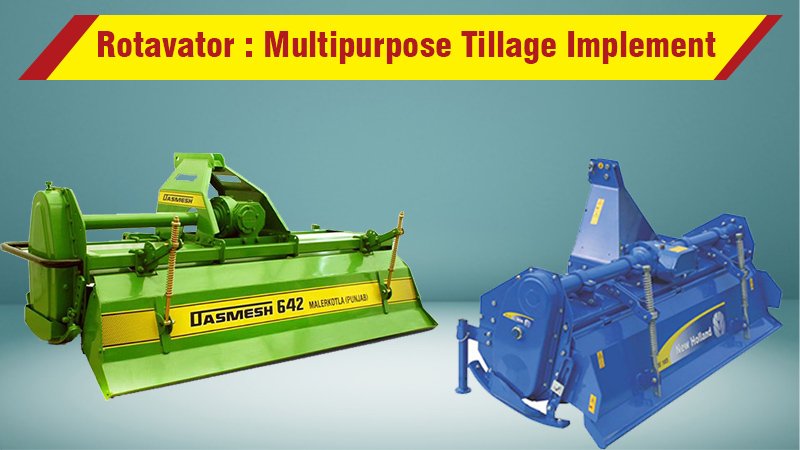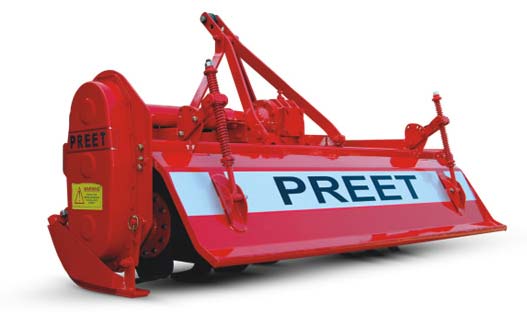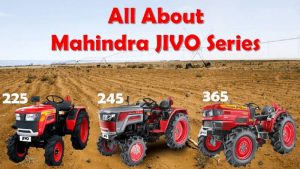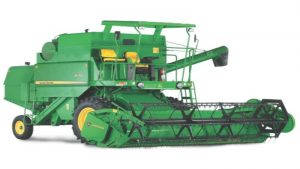Tractor Implement that cuts and pulverizes the soil by impact forces through a number of rotary tines or knives mounted as a horizontal shaft. It is also called “rotary tiller”. It is suitable for shallow cultivation and weed control.
It consists of a power driven shaft on which knives or tines are mounted to cut the soil and trash. Rotor has got several types of tines fitted on the shaft having a speed of 200-300 rpm. Generally, sharp-edged L-shaped blades are used on the rotor. According to the power used, rotavators are classified as engine operated and tractor-drawn rotavators.
One or two operations of this implement are sufficient for good pulverization of soil depending upon soil and crop conditions. It is not meant for sandy soil. The power from the engine to rotor shaft is transmitted through chain or gear.
A clutch is provided in the transmission system for engaging and disengaging power. The speed of the rotor is kept at about 350 rpm for rated rpm of 1500 of the prime mover. The depth of penetration can be adjusted up to 12.5 cm. The suitable protective cover is provided at the rear to prevent under a scattering of soil.
It can cover about 1.5-2.0 ha/day. The bullock-drawn engine operated rotary tiller is quite useful for timely preparation of seedbed, particularly in the rice-wheat rotation. Power tiller operated rotary tillers are also quite useful for hilly areas and small hand holdings.
Rotary tillers are becoming popular in rice growing countries throughout the world for lowland cultivation.
Leading Rotavator Manufacturers in India:
Many makes of rotavator are available in India with various brand names. The some of leading manufacturers of rotavators are:
• Shaktiman
• Sonalika
• Dasmesh Group
• MASCHIO
• Mahindra
• Swan
• John Deere
• Krushivator
• PREET
To find any details information and can compare models of many Indian-made rotavators on the Khetigaadi website and Mobile app.
Types of rotary tiller (Rotavator)
There are two types of rotary tillers. One acts as an integral part of the power tiller whereas the other is a separate entity mounted on the tractor hydraulic system and powered by the tractor PTO shaft.
Types of blade used in rotavator.
Tractor Implement and other agricultural products. Find Tractor Implement, Tractor Accessories, mini tractor implements .
Different types of blades are used for different field conditions:
A. L-shaped blade: Most common as the shape is superior to others in heavy thrash. They are better to kill weeds and generally cause less soil pulverisation.
B. C-shapes blade: Penetrating hard ground is easier with these blades. They are more curved than L-shaped blades and are recommended for heavy, wet soils because they have fewer tendencies to clog.
C. Long shank blade: They have longer shank than the L-shaped blade and can be used for deeper cultivation.
D. Speed blade: Especially suitable for penetrating the hard ground and for mixing heavy thrash. Have fewer tendencies to clog in wet condition.
E. Straight knife blade: These simply slice through the soil to aerate and loosen grass, eliminate soil compaction and improve moisture penetration. The primary application is for lawns, parks and golf courses.
Power transmission in a rotavator
The rotavator takes the power directly from the tractor PTO through a shielded double universal joint shaft to the rotor gearbox. The power requirement for the tiller is about three times as much as that for the mould board ploughs. Tractors for these units should have 40 HP (PTO) per meter width.
The gearbox has a crown wheel and pinion, part of the interchangeable spur gear and a rotor engagement clutch alters the rotor speed by transposing or changing the pairs of spur gears. Generally, there are two pairs of gears to obtain four rotor speeds.
Multiple plate clutch is provided before power input to the gearbox. The drive from the gearbox is then transmitted to the rotor shaft. Depending on the machine design and the operating width, the drive may be either from the centre or offset.
Drive from the centre reduces the number of components as the power is transmitted via directly from the PTO shaft through the gearbox to the rotor shaft while in the offset drive the power from the gearbox is transmitted via a transverse shaft to gears or sprockets & finally to the rotor shaft.
Application of rotavator:
1. Chopping and mixing: Rotavator with its chopping and mixing ability is ideal for crops such as maize, sorghum, tobacco, sugarcane, cotton, rice etc. The thrash mixed evenly throughout the soil adds valuable humus to the land.
2. Tilling and Planting: To reduce further operations, many rotavators may be equipped with a toolbar mounted planter or a hitch for towing a planter for tillage and planting operations. By rearranging blades on the rotor shaft, the rotavator may be used for strip tillage in the seedbed.
3. Fertilizer and chemicals: may be incorporated by spreading in bands or broadcast from tanks or hopper on the tractor or rotavator by broadcasting ahead of the implement. The stirring, mixing action of the rotavator provides excellent incorporation of pre-emergent chemicals.
4. Cultivating: By rearranging the blade flanges on the rotor shaft, most tillers may be used for row crop cultivation. Rotor diameter and operating depth are limiting factors in the size of plants that may safely be cultivated in this manner.
5. Orchard Tilling: Rotavators are used in vineyards, citrus groves and orchards because it is easy to control operating depth to prevent damage to trees or vine roots. They provide sufficient mulch to conserve moisture. Some rotavator models are built for offset operations. The offset permits working under trees.
6. Rice field: Rotavators are adapted to work in wet rice fields. The rotating blades help push the tractor forward and reduce wheel slippage, where it would be difficult to gain traction for plough and disc operations. Heavy rice straw may be chopped and mixed with the soil to improve fertility and soil structure.
7. Weed control: As many as 3-5 passes at 2-3 weeks interval may be required to completely eradicate annual and. perennial weeds. Operate the rotavator with a fast rotor speed and the shield raised so that the roots are thrown on the surface to die.
8. Pasture renovation: Pasture renovation with a rotary tiller involves breaking up and kills the sod, mixing residues in the soil, incorporation of fertilizers and herbicides. Levelling of the surface and preparation of seedbed.
Want to know more about tractor, tractor price, Tractor Implement, Tractor Videos, and Tractor Games then visit our site.
Written by: Er. Vipin Y Sule
Er. Vipin Y Sule has completed M. Tech in farm machinery & power engineering from Anand agricultural university, Anand Gujarat. He is an expert in Farm Machinery and Power Engineering.
He currently serves as Assistant Professor of Dr Budhajirao Mulik College of Agricultural Engineering and Technology, Mandki- Palvan. Previously he was worked with Sahyadri college of agricultural engineering karad.
Related Articles:






